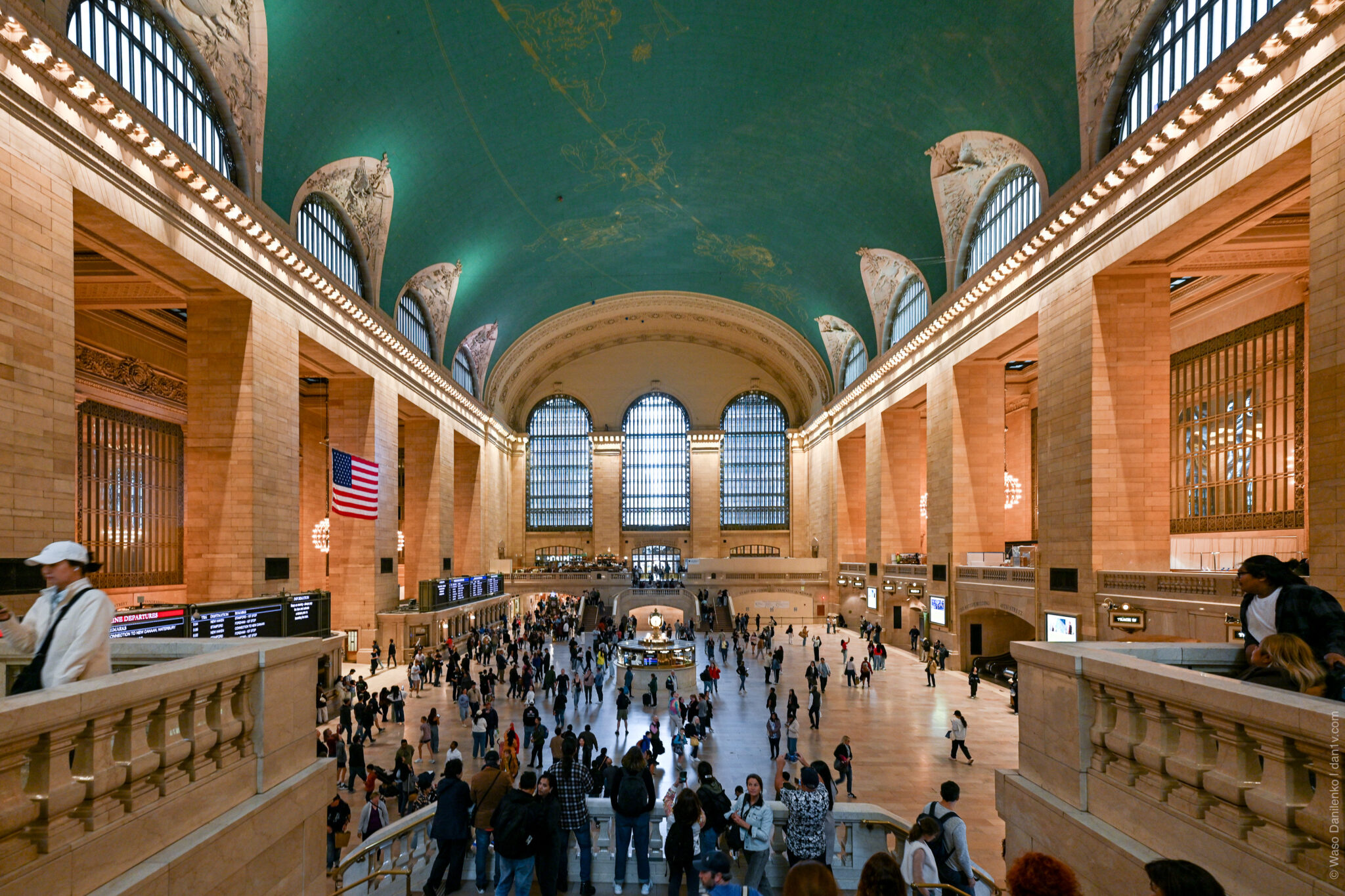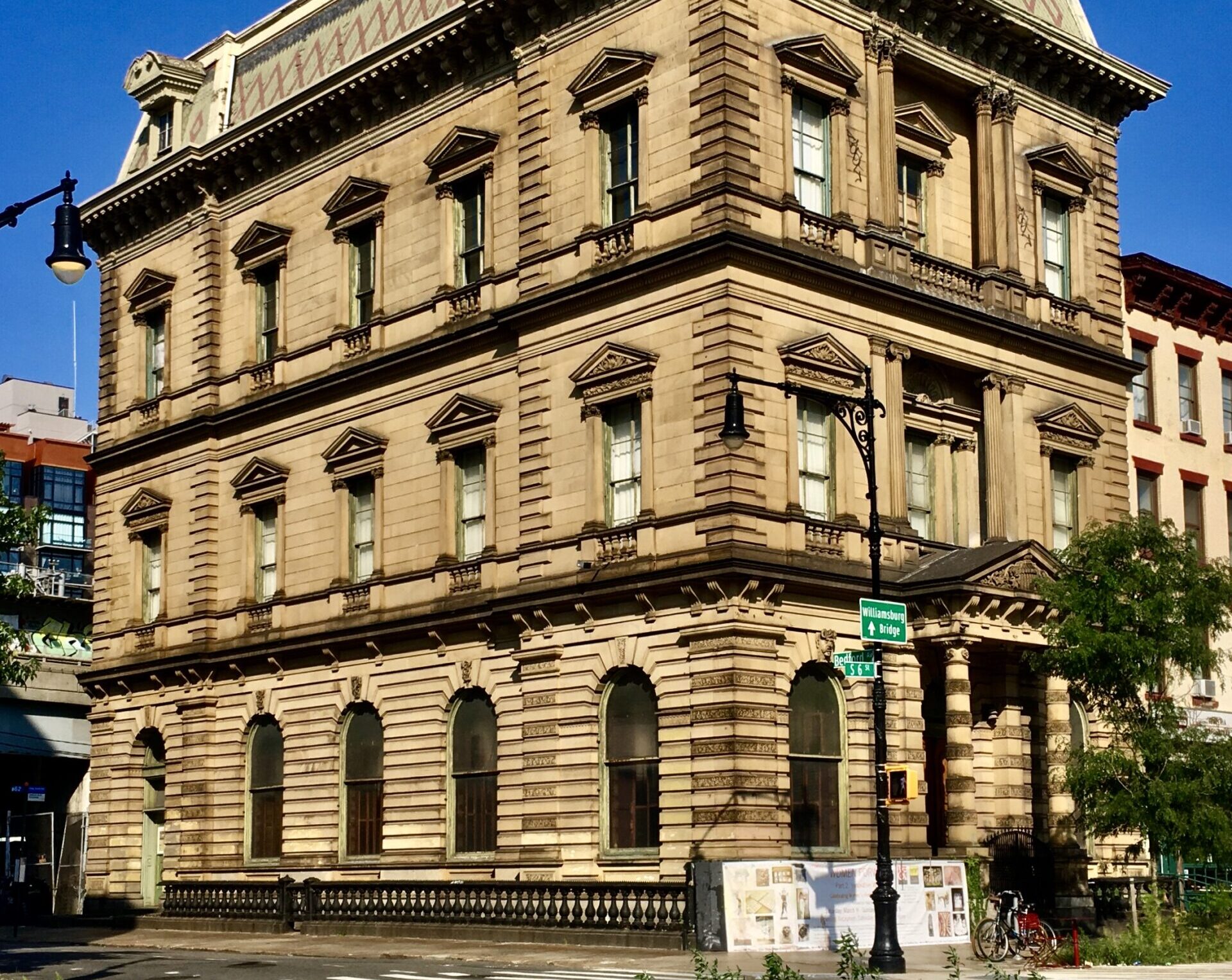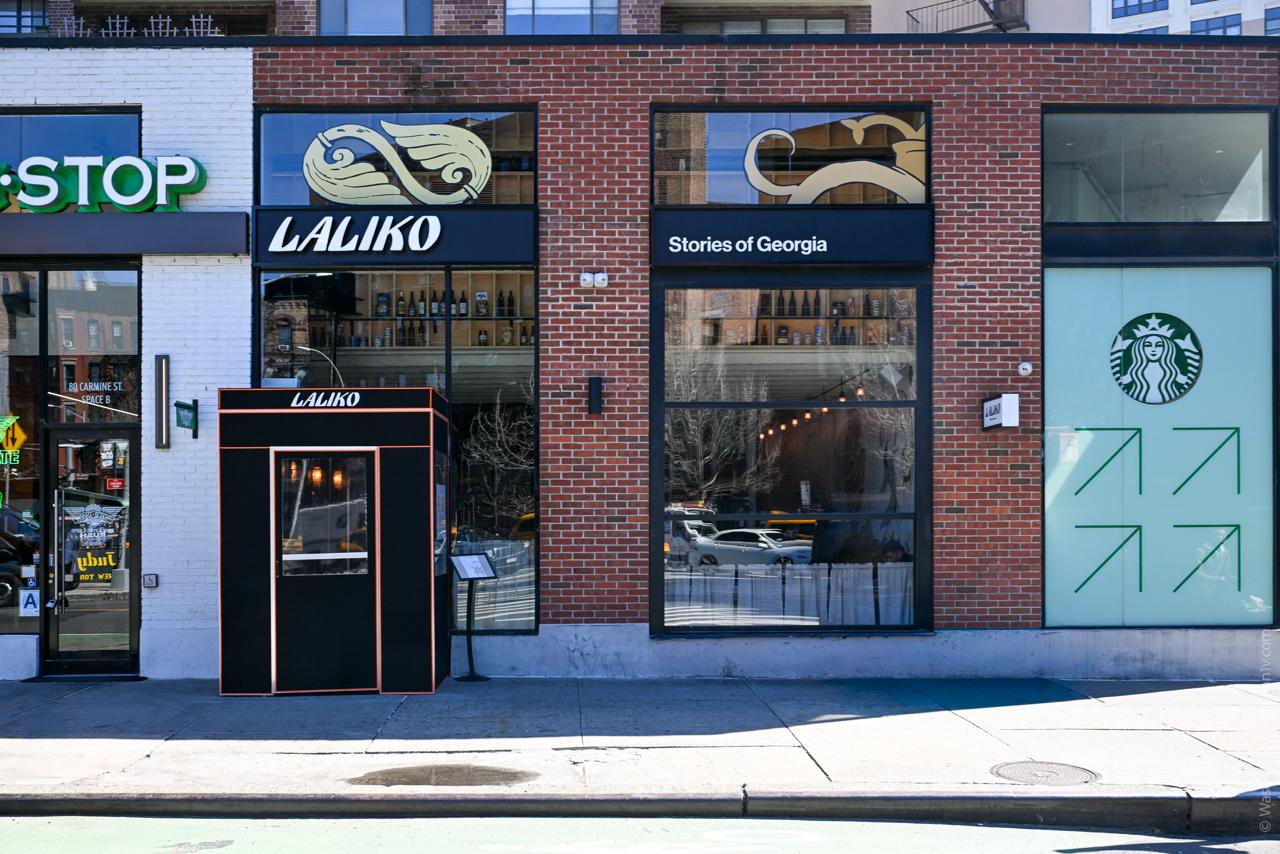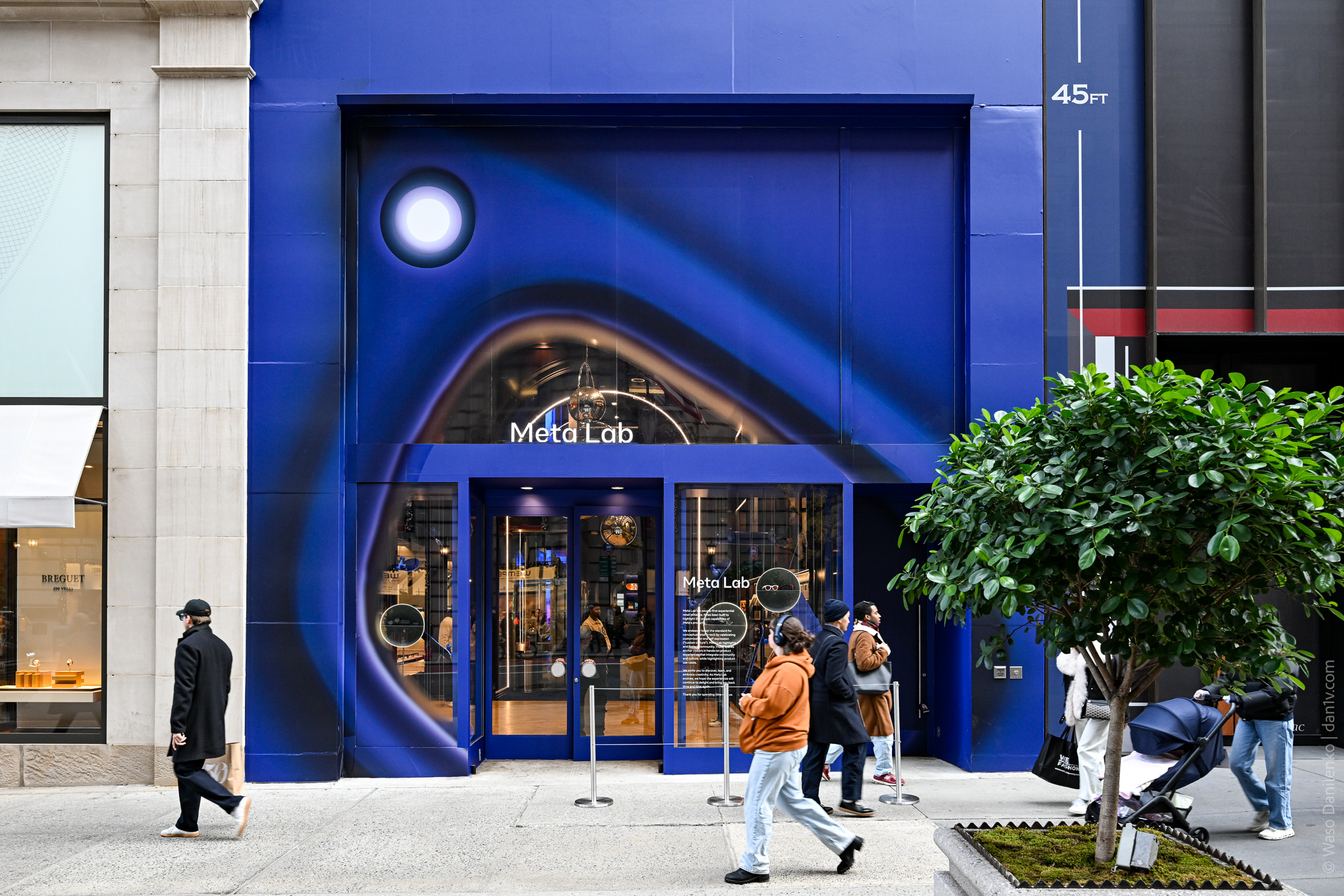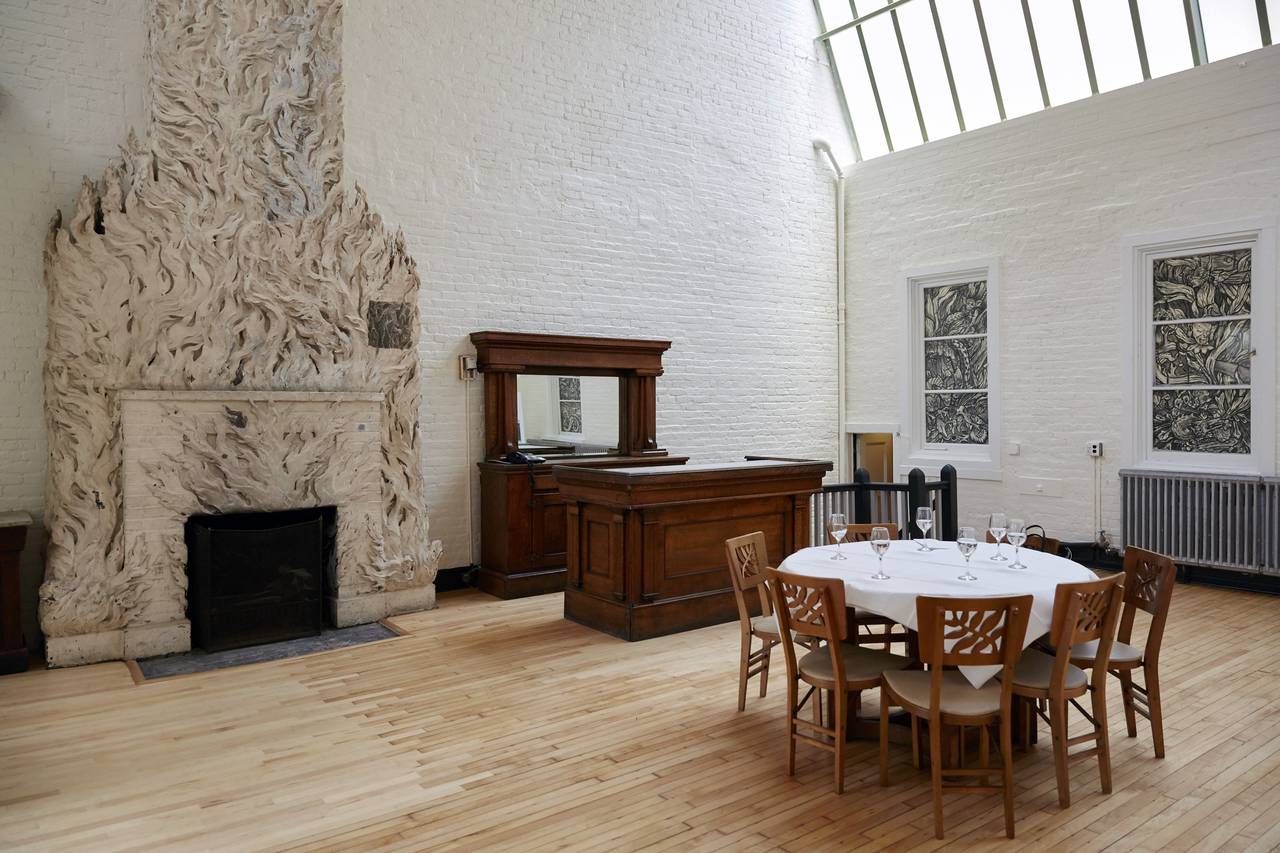Grand Central Terminal, also known as Grand Central Station in New York, is one of New York’s most striking landmarks and, as it happens, the largest passenger railway station in the world in terms of number of platforms and total area.
Early History
- Grand Central Terminal opened on February 2, 1913, after 10 years of construction at a cost of $80 million.
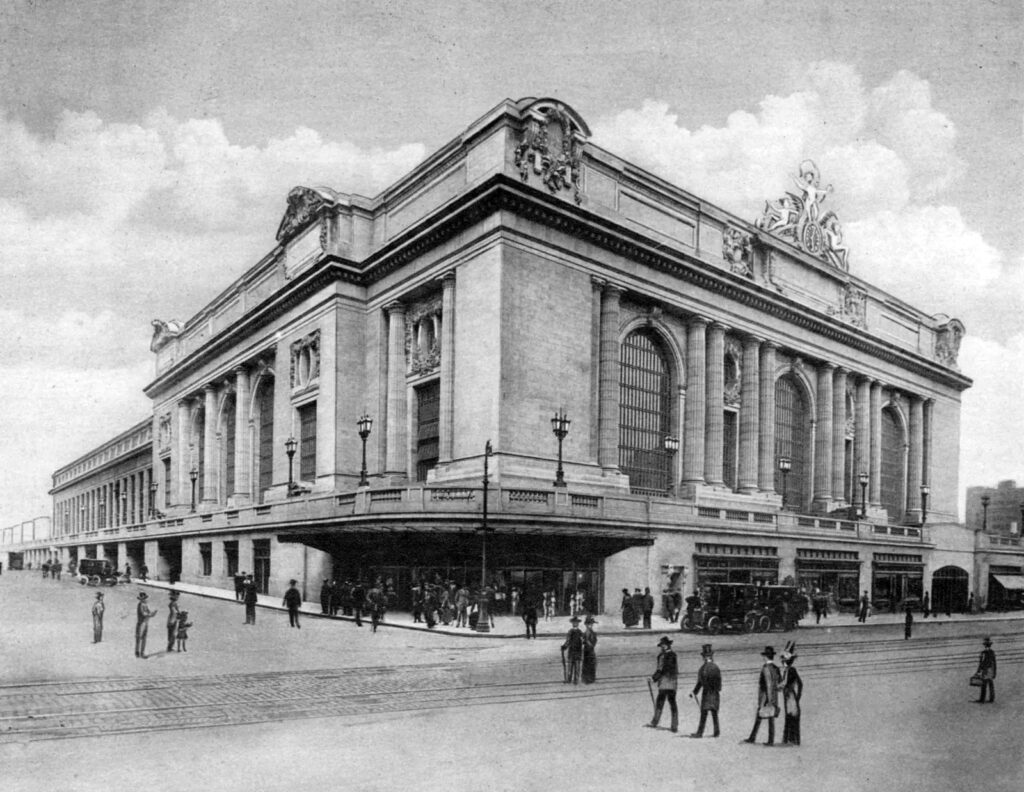
- The building was constructed on the site of two previous stations: Grand Central Depot (opened in 1871) and Grand Central Station (1900–1910).
- The chief engineer was William J. Wilgus, who proposed a revolutionary two-level platform layout and the use of electric traction. All platforms and tracks are located underground.
- Grand Central was the first terminal to make extensive use of ramps, almost completely eliminating stairs.
- To finance the construction, air rights — the right to construct buildings over railroad tracks — were sold for the first time in history, spurring the development of the Terminal City area.
- The station was built without interrupting train service, despite extensive excavation work (soil was transported by rail and used to widen the tracks at Croton-on-Hudson).
- Grand Central Terminal covers 19 hectares (48 acres) and is the largest train station in the world by platform count—44 platforms and 67 tracks (30 on the upper level, 26 on the lower level).
- On its opening day, the station attracted over 150,000 visitors.
- Grand Central Terminal became a catalyst for the development of the surrounding area: Terminal City included office buildings, hotels (such as the Commodore Hotel), luxury residential buildings, and the Chrysler Building.
Architecture
The station was rebuilt three times: Grand Central Depot (1871) ➡️ Grand Central Station (1900) ➡️ Grand Central Terminal (1913).
The current Grand Central Terminal was designed by two leading New York architectural firms: Reed & Stem and Warren & Wetmore.
Learn more about Reed & Stem and Warren & Wetmore
Reed & Stem was founded in 1891, changed its name to Wank Adams Slavin Associates in 1961, and shortened to WASA in 2004. However, in 2015, the company filed for bankruptcy and ceased operations. Their work includes train stations across the country, including the infamous Michigan Central Station in Detroit, as well as the current building, the Baryshnikov Arts Center.
Whitney Warren was a cousin of the New York Vanderbilt family and, together with his business partner and educational lawyer Charles D. Wetmore, was one of the most prolific architectural duos, focusing on hotels and train stations, which were enormous for their time. Incidentally, the main chapel at Green-Wood Cemetery (1911) is also their work.
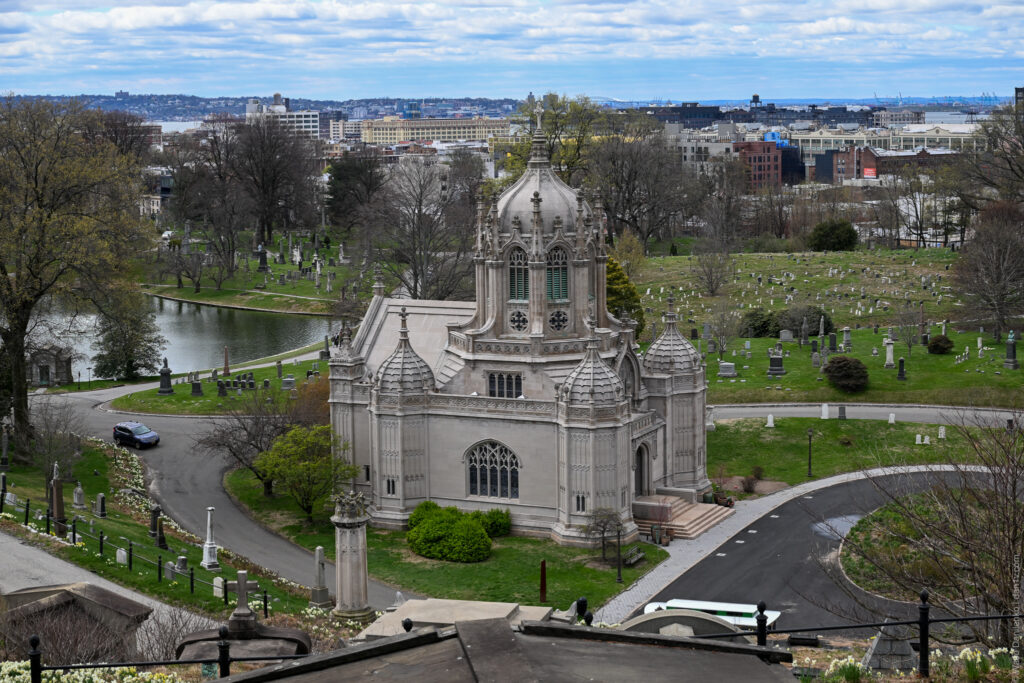
The station was built in the Beaux-Arts style (French for “fine arts”), drawing on classical and neoclassical architecture, Italian Renaissance, and French Baroque, as well as eclectic elements. Looking at the Grand Terminal building, you’ll notice the strict symmetry of its facades and layouts, and a clear hierarchy of spaces — from the grand entrances and staircases to the utility spaces. The style emerged in Europe in the mid-19th century, but became especially popular in the United States in the early 20th century, and Grand Central Terminal is a prime example.
The façade of Grand Central Terminal faces south, facing 42nd Street, and consists of three tall arched windows (approximately 18 by 9 meters each), separated by massive Doric columns. Designed as a triumphal arch symbolizing the triumph of railroads, it serves as the main, massive gateway into the city for those arriving in New York City.
The façade’s culmination is the Glory of Commerce (also known as Transportation) sculpture group, created by French sculptor Jules-Félix Cutano. The composition stands 15 meters high and 20 meters wide. When it opened in 1914, it was the largest in the world. In the center is Mercury (representing commerce and transportation), to the left is Minerva (wisdom), and to the right is Hercules (strength). Under Mercury is an eagle, the symbol of the USA.
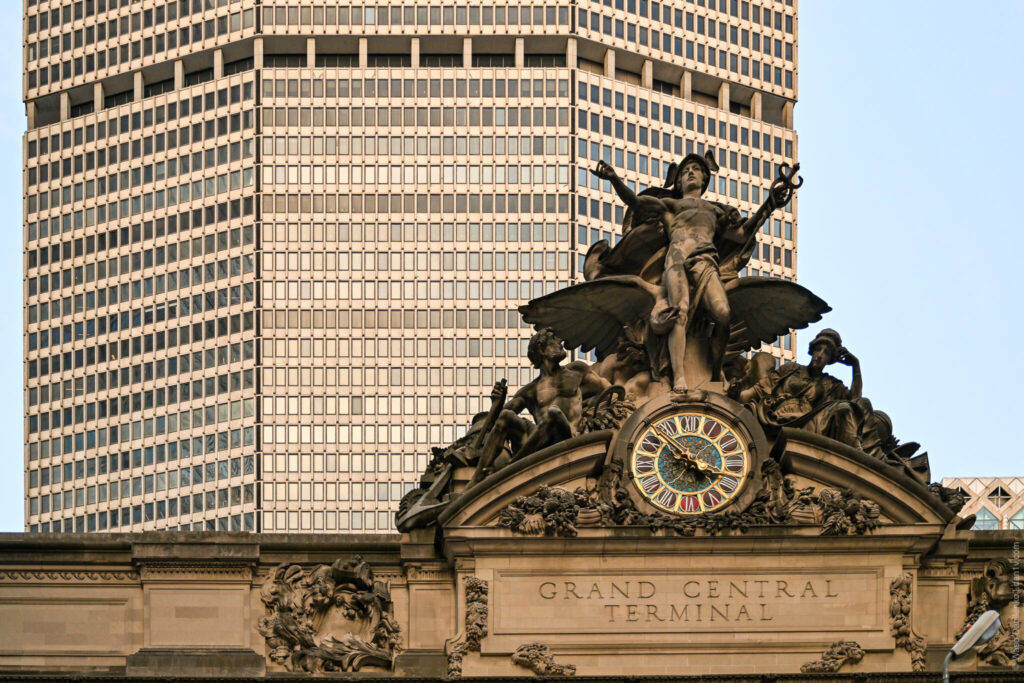
The sculpture towers over a giant Tiffany clock (4 meters in diameter) — the largest Tiffany glass clock in the world. The acorn and oak leaf symbols in the decoration are a reference to the Vanderbilt family crest, the founders of the station.
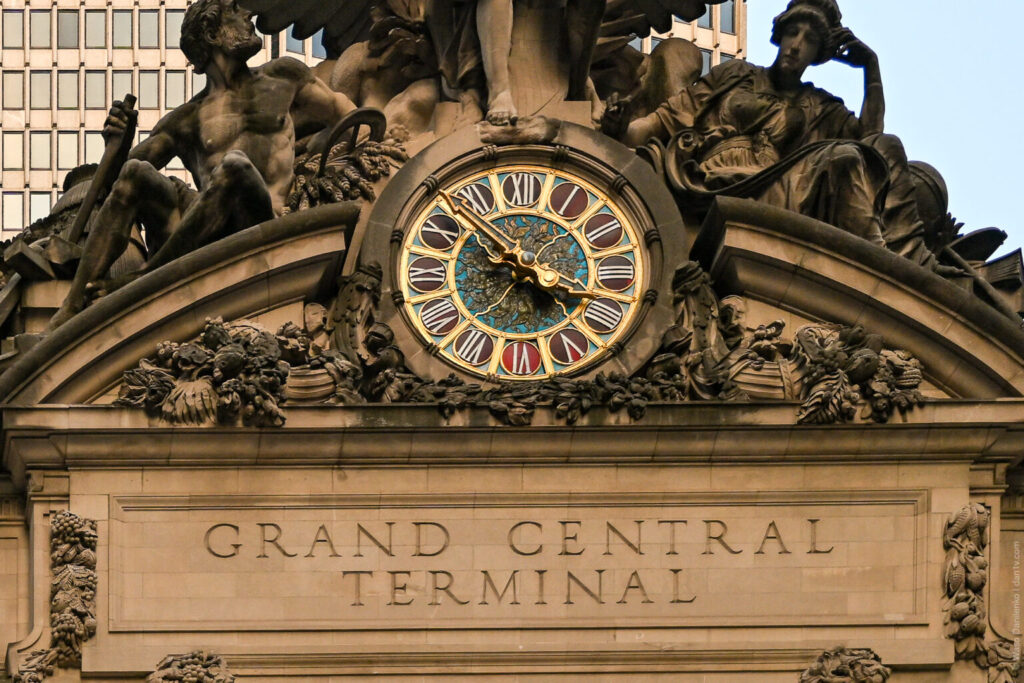
The ceiling
The ceiling of Grand Central Terminal’s main concourse is one of the station’s most impressive architectural features. The concourse reaches a height of 37 meters, and the ceiling itself is designed as a huge dome, painted with an astronomical fresco.
The mural depicts the sky with the 12 signs of the zodiac and approximately 2,500 stars, about 60 of which are illuminated by miniature bulbs simulating the starlight. The brightness of each bulb corresponds to the brightness of the corresponding star in the real sky.
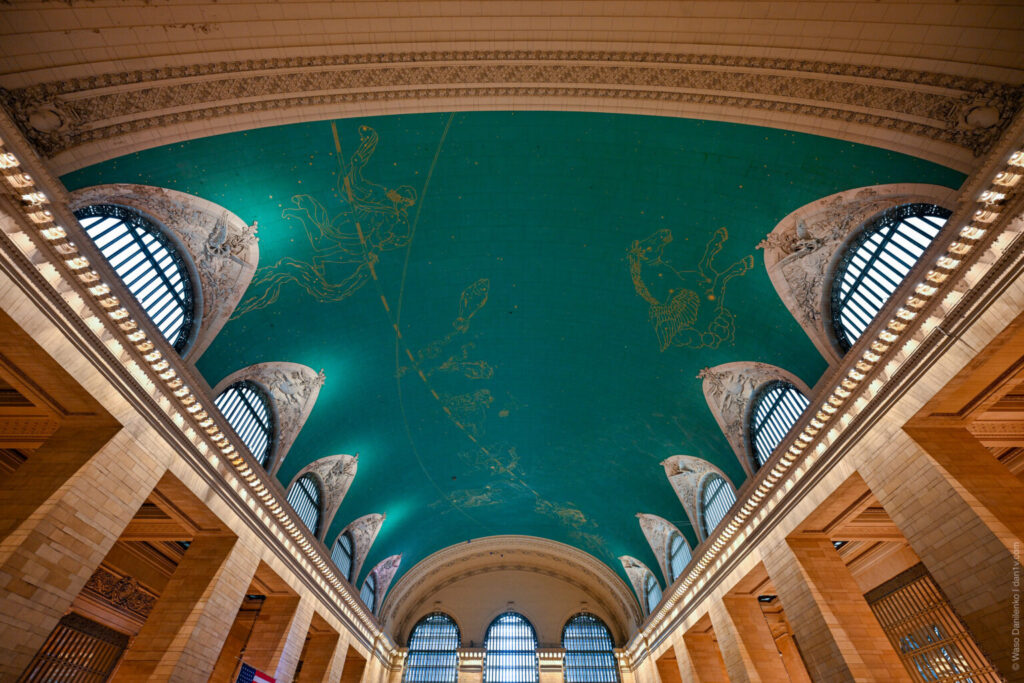
Amusingly, the stars are arranged in a mirror image, and according to one theory, this was a trivial and very unfortunate mistake made by the contractors who transferred the image from paper to the ceiling. The error was noticed shortly after the terminal opened, but the decision was made not to repaint the ceiling.
By the end of the 20th century, the ceiling was completely covered in a layer of nicotine stains and soot due to constant smoking at the station. In the 1990s, a large-scale restoration was undertaken, during which the original painting was restored.

One small section of the ceiling (in the northwest corner, next to the claw of the crab) was left uncleaned intentionally — as a reminder of the dangers of tobacco smoke and of the ceiling’s appearance before restoration. Moreover, it is believed that the claw of the crab (referring to lung cancer) was chosen deliberately.
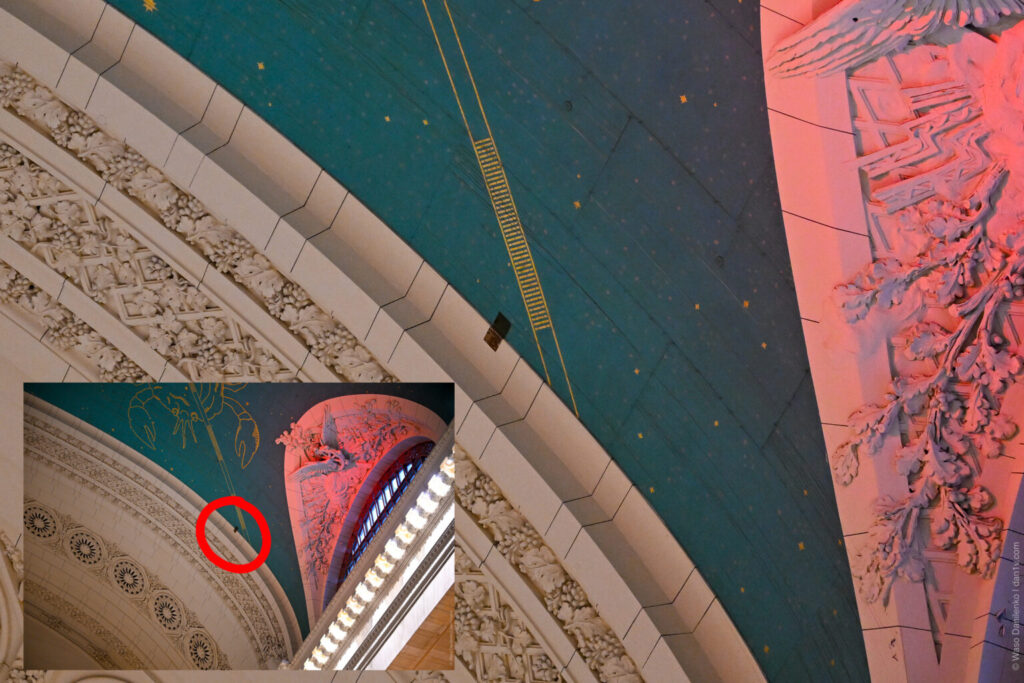
Traffic and operations today
Grand Central Terminal is the third-busiest train station in North America and the tenth-most visited tourist attraction in the world (21.6 million tourists in 2018, excluding passengers).
The station serves over 750,000 people daily, and up to a million if tourists are included. Incidentally, Tokyo holds the record for passenger traffic, with approximately 3.5 million people riding trains daily.
There are 67 tracks on two levels: 30 on the upper level and 26 on the lower level. Forty-three of these are used for passenger travel. During the morning rush hour, trains arrive every 58 seconds.
Main destinations and cities you can travel to directly from this station:
- Harlem Line: Upstate New York. Terminates in Wassaic, New York.
- Hudson Line: Along the Hudson River, scenic routes include Poughkeepsie, New York. Alternatively, connect with Amtrak to Albany.
- New Haven Line: To New Haven, Connecticut. Transfer to Amtrak to Hartford, Springfield, Boston; or to Shore Line East to New London.
Since 2023, the Grand Central Madison underground terminal has been serving LIRR trains. This service connects you to most cities on Long Island.
Best Day Trip Options:
- Cold Spring and Beacon (Hudson Line): cozy towns, antique shops, museums, walks and hikes in the Hudson Highlands.
- New Haven, CT (New Haven Line): Yale University, architecture, famous pizza.
- Long Beach, NY (LIRR): beach, ocean, walks along the embankment.
- Poughkeepsie, NY (Hudson Line): walkway Over the Hudson bridge, historic estates.
- Stamford, CT (New Haven Line): business center, restaurants, theaters.
- Huntington, NY (LIRR): museums, parks, restaurants.
The amazing stories and secrets of the Grand Center Terminal
The Nazis almost blew up the station
Legend has it that Nazi saboteurs attempted to blow up Grand Central Terminal during World War II.
A secret electrical substation, codenamed “M42,” was hidden in the underground levels of Grand Central Terminal. It was responsible for powering trains and the entire terminal’s infrastructure. During World War II, it played a critical role in supporting military transport: soldiers and equipment passed through the terminal daily on their way to the front.
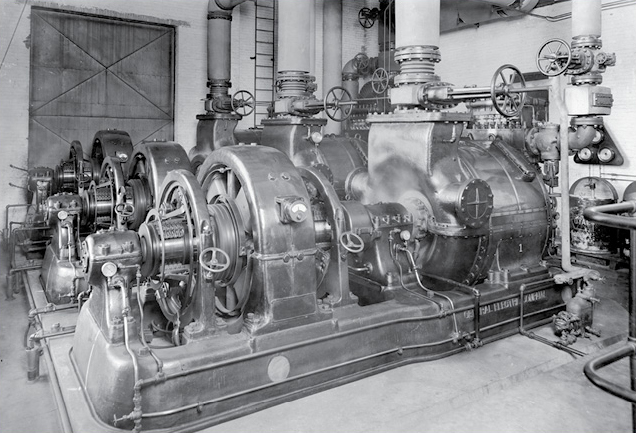
Allegedly, Nazi spies were to infiltrate the M42 substation and disable it by throwing sand into the rotating converters, which would stop trains and disrupt military transport.
However, there is no documentary evidence that M42 or Grand Central Terminal were targets of Nazi operations, and the story about the station is most likely pure fiction.
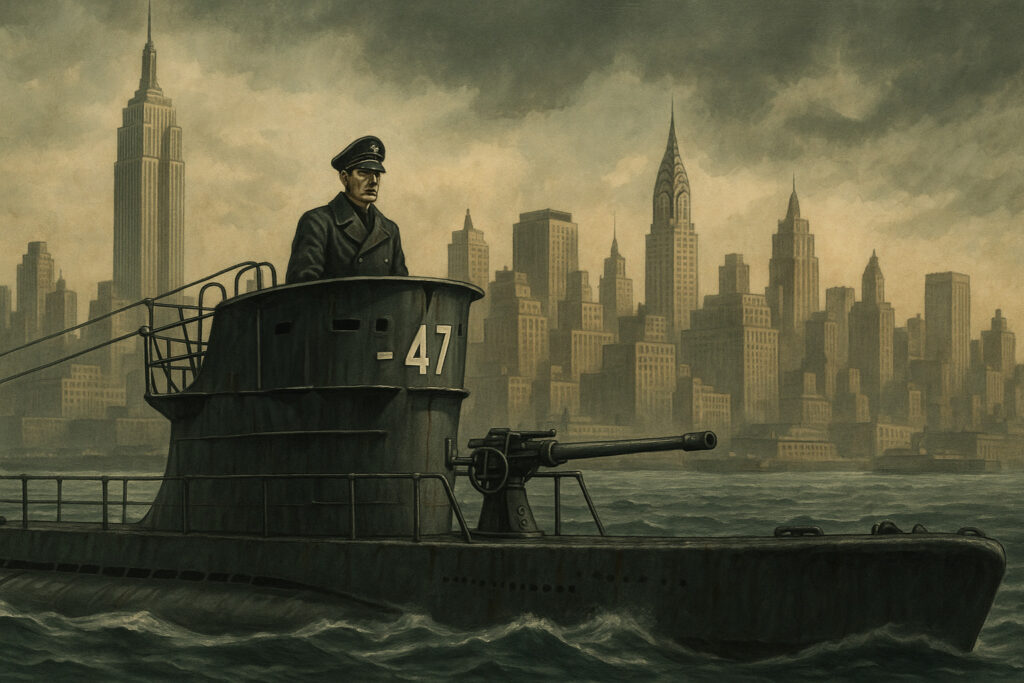
Interestingly, it’s a fact that Nazi saboteurs did operate on US soil, and it was called Operation Pastorius. In June 1942, two groups of four men each were dropped from German submarines off the coasts of Long Island and Florida. Their goal was to sabotage American industry, including aluminum smelters and railroad infrastructure. However, Grand Central Terminal and the M42 substation are not mentioned among their targets in official documents, including MI5 reports and court-martial transcripts.
Ballistic missile at the Central Station
In 1957, the USSR launched the first artificial satellite (named Sputnik 1), so the space race was at its peak that year, so the US decided to put on a spectacular and, most importantly, high-profile PR campaign to support its space program and… installed a 20-meter-tall, real RedStone ballistic missile inside the station terminal building for three weeks. In fact, that’s why they had to drill a hole in the ceiling to securely mount the missile.
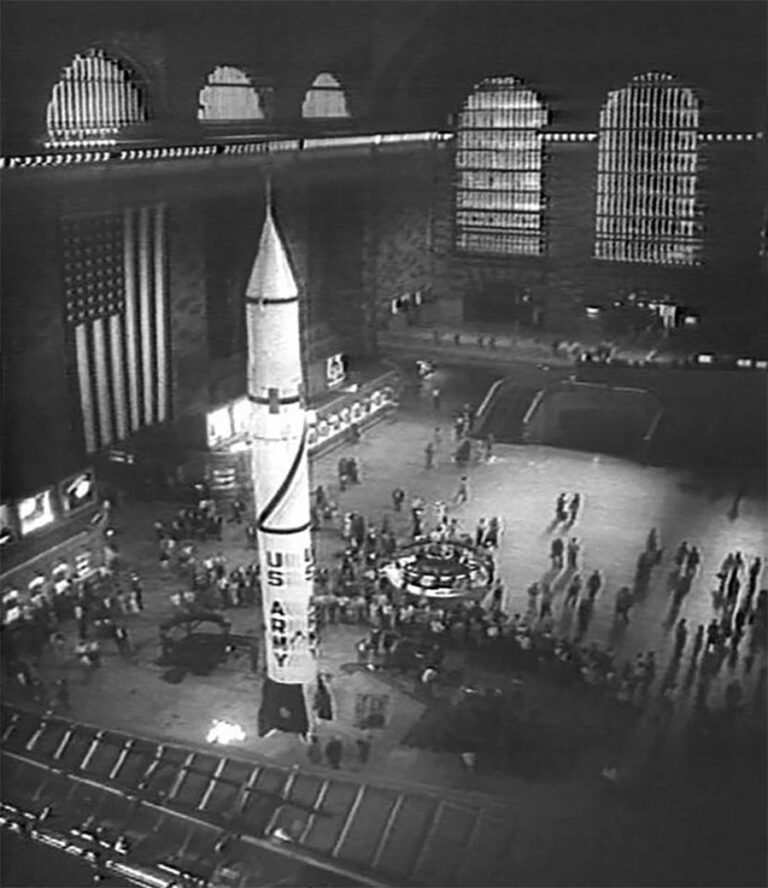
The station miraculously escaped demolition
After World War II, the automobile boom began, with massive interchanges and highways being built in New York City. Against this backdrop, rail traffic declined sharply, leading to financial difficulties for railroad magnates, who considered selling the Grand Center Terminal building or its air rights to build a massive office skyscraper directly above or in its place.
In 1968, Penn Central commissioned architect Marcel Breuer to design a 55-story tower that would literally “sit” on the roof of the terminal. This sparked outrage among the public, architects, and historic preservationists.
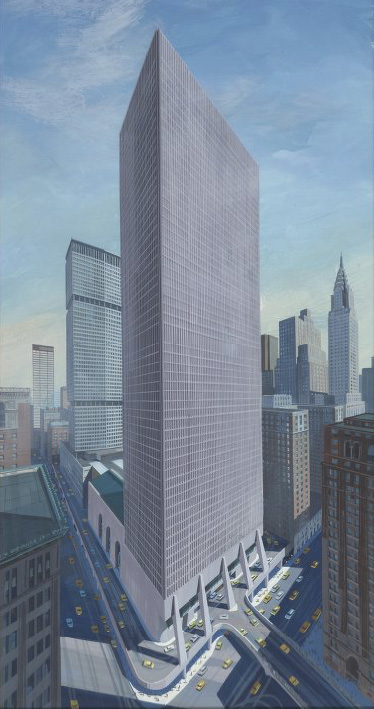
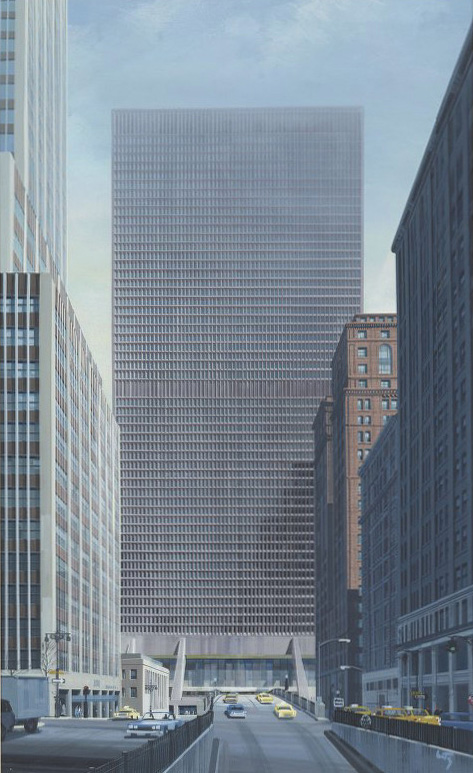
Jacqueline Kennedy Onassis, the wife of the former First Lady of the United States, played a key role in saving the station, becoming the public face of the campaign to protect Grand Central Terminal. She joined the Municipal Art Society, participated in rallies, wrote open letters to the mayor, and actively spoke in the media, drawing national attention to the issue. Thanks to her authority and activism, the issue reached the federal level.
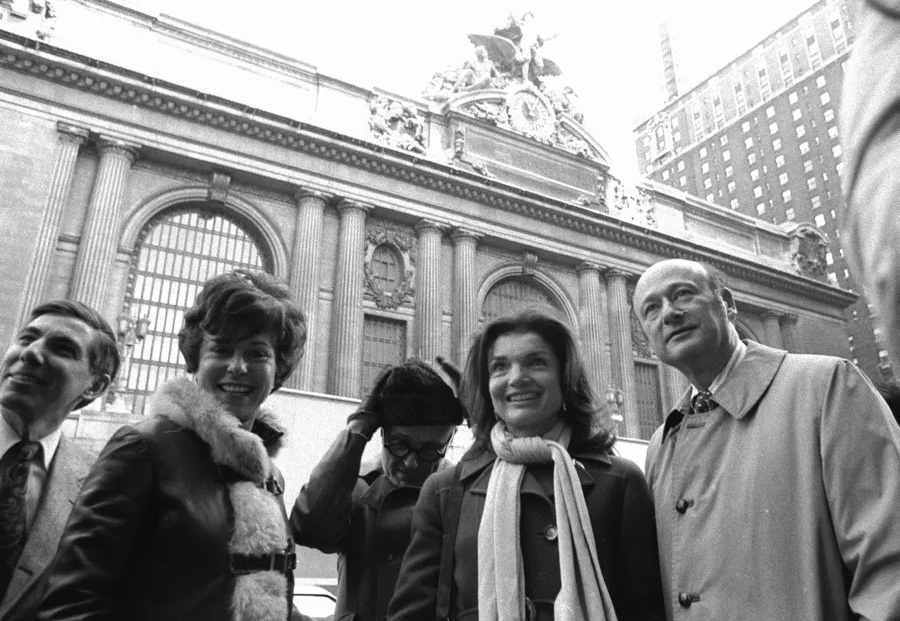
In 1975, Penn Central sued the City of New York, claiming that the ban on demolishing the station violated their property rights. The case went all the way to the U.S. Supreme Court, which in 1978 issued a landmark ruling: the landmark preservation law did not violate the Constitution, and Grand Central Terminal should be preserved as a national treasure.
In memory of Jacqueline Kennedy Onassis, the main south concourse of the station today bears her name, and a commemorative bronze plaque is installed on the wall.
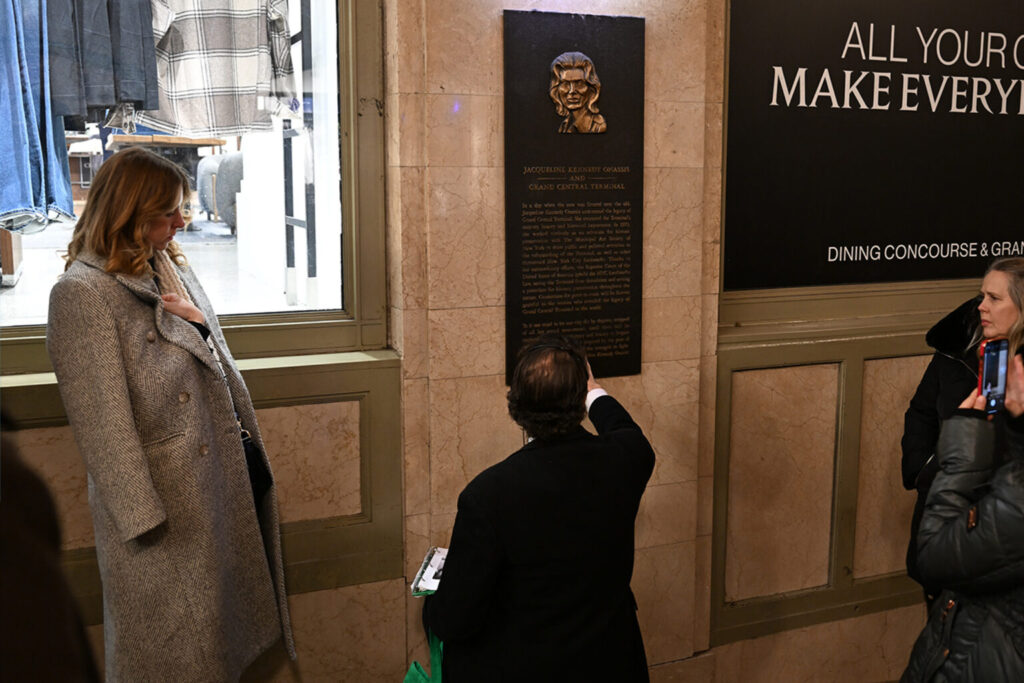
In 1967, the building was designated a city landmark, and in 1976, a U.S. National Historic Landmark. In 1978, the U.S. Supreme Court protected the station from demolition, setting a precedent for the preservation of historic buildings in the country.
Secret Platform 61
Track 61 is a secret train platform located beneath the famous Waldorf Astoria hotel in New York City, part of the underground Grand Central Terminal complex. It was not intended for general passengers and was originally built as a siding for power plant maintenance and ash removal in the early 20th century.
After the Waldorf Astoria was built in 1929, the platform became a hidden entrance for VIPs. The most famous instance involved President Franklin D. Roosevelt. He allegedly used Track 61 to enter the hotel undetected, concealing the effects of polio from the public. His armored limousine was transported by train directly beneath the hotel, where it, along with the president, was lifted in a special freight elevator into the Waldorf Astoria garage.
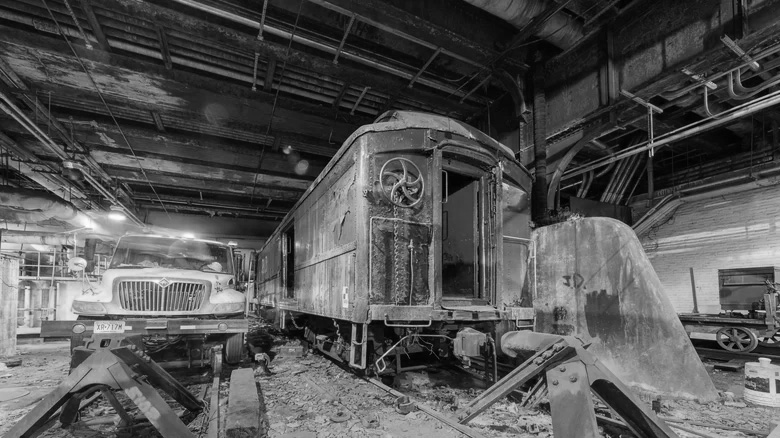
Track 61 often appears in urban legends and films as a secret presidential route, although it is known for certain that Track 61 was used for various events, such as presentations of new locomotives, fashion shows, charity dinners, and even hosted an Andy Warhol party there in 1965.
A movie theater inside New York’s Grand Central Station
Since 1937, Grand Central Terminal has housed an unusual space for a station: its own movie theater, the Grand Central Theatre, located next to Track 17. Designed to seat approximately 240 people, it was specifically designed for passengers waiting for trains or connections. The program was curated with short wait times in mind: short films, news reports, documentaries, and cartoons were featured.

The cinema’s interior was decorated in the then-fashionable Art Deco style. It was considered one of the most intimate movie theaters in New York City: open until midnight, featuring a small bar and even a standing area. To ensure viewers didn’t miss their train, a large clock hung near the screen.
The first showing took place on May 3, 1937, and the theater opened with the MGM film “Servant of the People: The Story of the Constitution of the United States.” The architect was John Sloan of Sloan & Robertson, and the interior design was by Tony Sarg, the man who designed the first balloons for the Macy’s Parade.
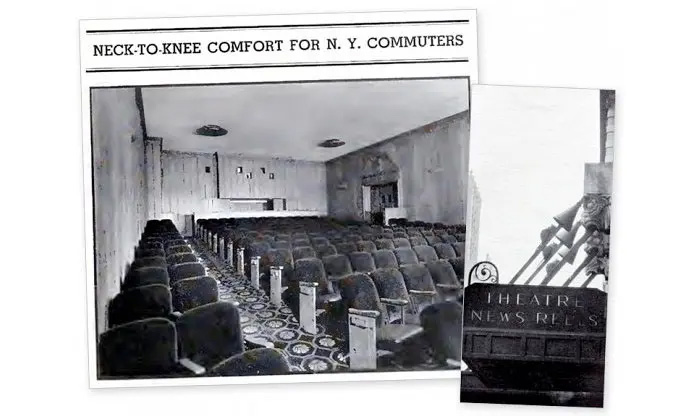
The cinema operated for about 30 years and closed in the early 1970s. Its premises were later occupied by a photography studio, and then by the Grande Harvest Wine shop, which still stands on the site.

During restoration in the 1990s, part of the original cinema ceiling was discovered, decorated with a star pattern that echoes the ceiling of the station’s main hall.
A tennis court inside Grand Central Terminal that once belonged to Trump
It’s hard to believe, but Central Station used to have an artificial ski slope, and now it’s home to one of the most expensive tennis courts.
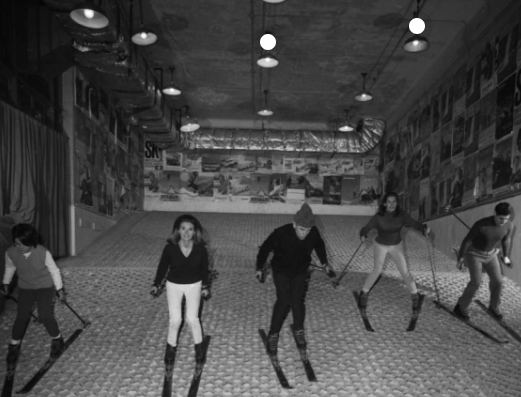
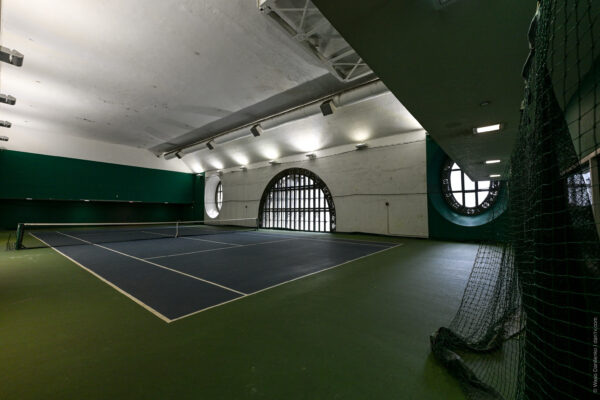
New York’s Grand Central Station is the birthplace of the red carpet
In the early 20th century, rail travel in the United States was a symbol of prestige, and Grand Central Terminal was the main gateway to the outside world for New Yorkers and visitors.
The most famous and luxurious train in American railroad history was the 20th Century Limited, which ran between Grand Central Terminal in New York and LaSalle Street Station in Chicago.
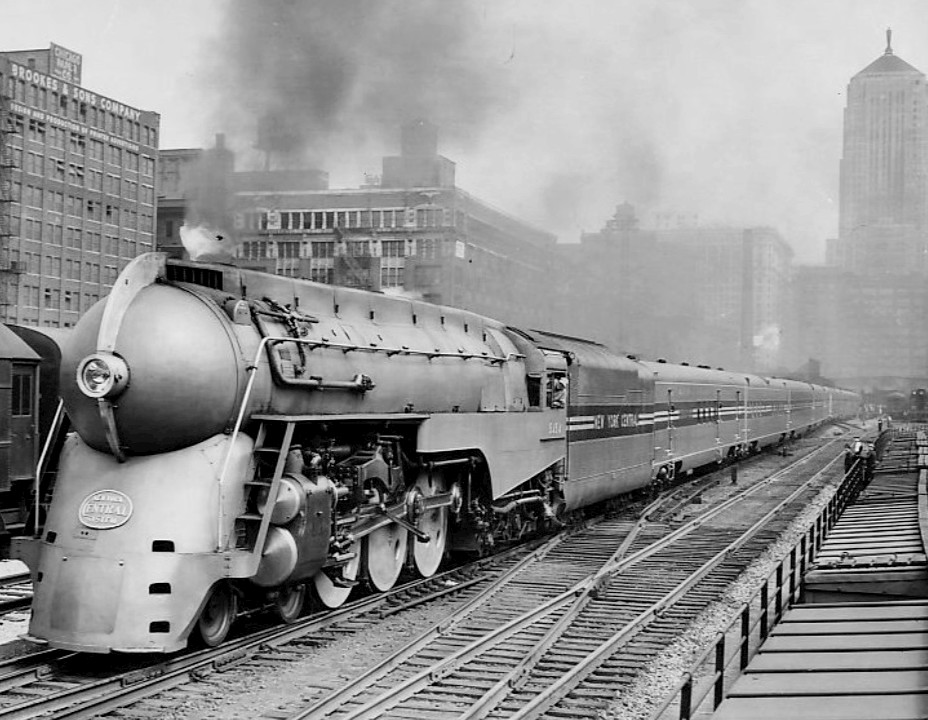
The route was launched in 1902 by the New York Central Railroad and was considered a millionaire’s train: luxurious carriages, a restaurant, a bar, sleeping compartments, and a red carpet for boarding.
The train departed in the evening so passengers could arrive in the morning and get straight to business. The journey took approximately 16-17 hours. Passengers boarded and disembarked via Track 34, which was lined with a red carpet.
The 20th Century Limited became a symbol of railway luxury and featured in numerous films and novels, making the phrase “red carpet treatment” famous. The symbolism of the red carpet—wealth, status, and special treatment—has migrated from transportation to the world of show business and is still associated with special attention to guests and event participants.
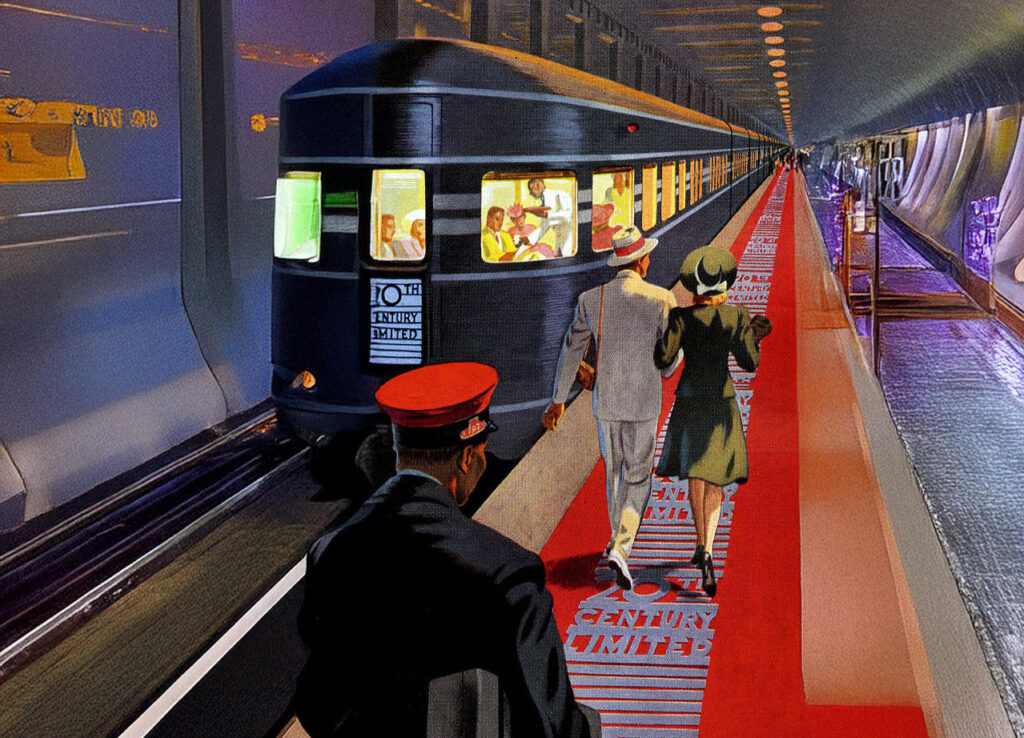
This red carpet ritual at New York City train stations became one of the sources of inspiration for the Hollywood red carpet at premieres and ceremonies, according to cultural scholars and historians.
The train ceased service in 1967, but its reputation and attributes of special status live on.
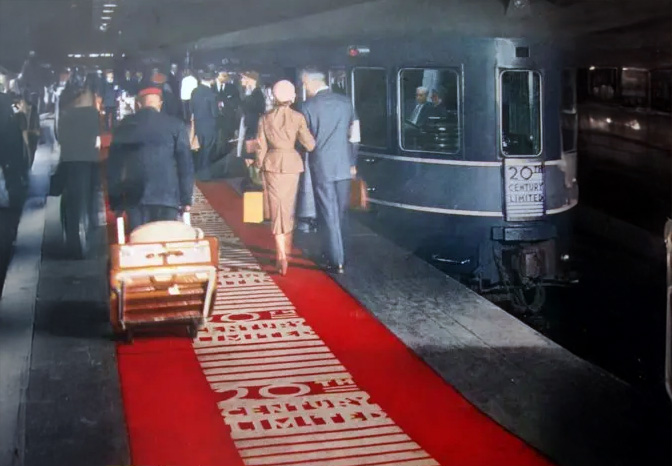
Cafes, bars, and restaurants in New York’s Grand Central Station
Grand Central Terminal is not only a transportation hub but also one of New York City’s most vibrant culinary destinations. It features legendary restaurants, modern cafes, bars, bakeries, and a food market. Here are the most interesting and iconic spots:
Grand Central Oyster Bar
Grand Central’s Oyster Bar is more than just a fine seafood restaurant; it’s a true New York City culinary landmark, located on the lower level of the famous Grand Central Terminal. Opened alongside the station in February 1913 as the Grand Central Terminal Restaurant, the Oyster Bar was originally just a small oyster stand. However, by the 1910s and 1920s, it had become a cult favorite thanks to its signature dishes: oyster stew, pan-roasts, and dozens of varieties of fresh oysters and shellfish — a rarity at the time.

Over its more than 100-year history, the restaurant has experienced many ups and downs. During the Great Depression and the railroad crisis of the 1960s and 1970s, it fell into disrepair and even closed in 1974. After restoration, under the direction of restaurateur Jerome Brodie, the restaurant reopened, specializing exclusively in seafood. In 1997, the restaurant was severely damaged by fire, but was rebuilt and reopened in 1998.
Since 1999, the Oyster Bar has been owned by its employees, who have organized through a union and a stock ownership program. Even the COVID-19 pandemic hasn’t been devastating: after a forced closure in 2020, the establishment successfully reopened in 2021.
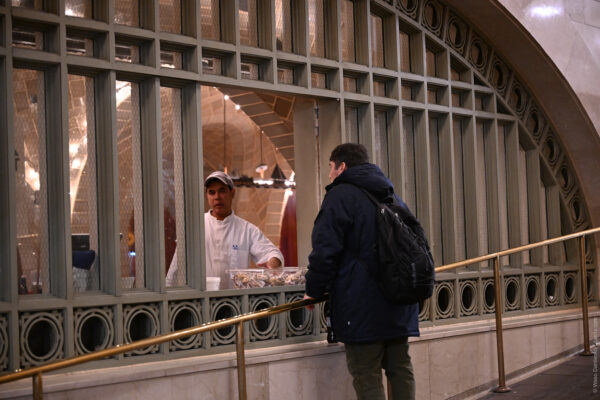
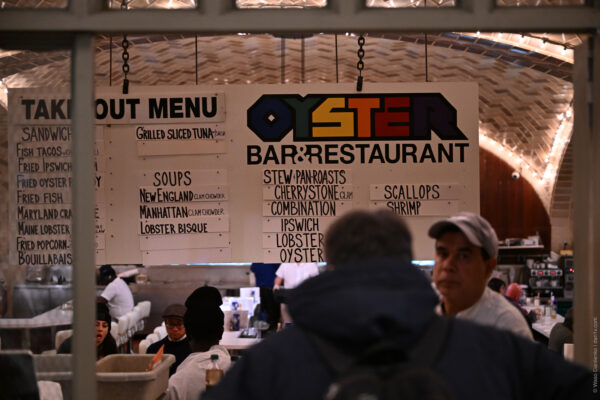
The restaurant’s interior is an architectural landmark in itself. It’s designed in the Beaux-Arts style, with unique vaulted terracotta ceilings designed by the renowned Rafael Guastavino. The entrance is adorned with the legendary “Whispering Gallery”: thanks to the unique acoustics of the vaults, if two people stand at opposite corners of the arch and whisper, they can hear each other perfectly.
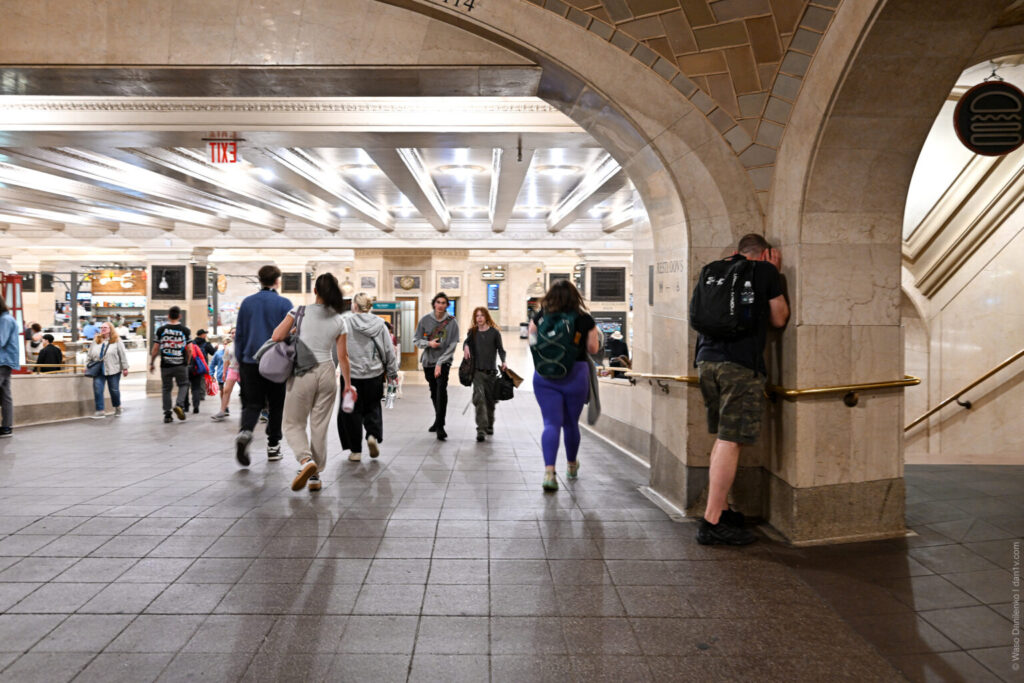
The restaurant’s dining room seats approximately 440 people, making it one of the largest seafood restaurants in the United States.

The Oyster Bar’s main feature is, of course, its menu, centered on the freshest oysters (up to 30 varieties served daily), the famous oyster pan roast, clam chowder, shrimp, lobster, crab, and grilled fish. Although the menu is regularly updated, the primary focus remains on the quality and freshness of ingredients. Guests can choose from a full dinner at the table or a quick snack right at the bar.
Grand Brasserie Restaurant
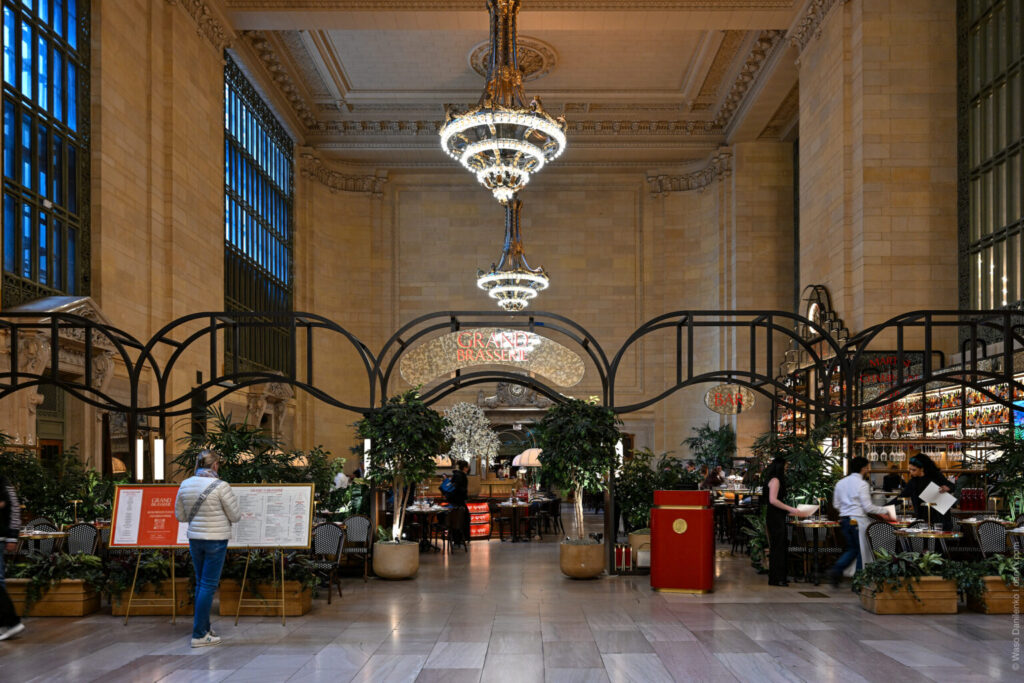
The Grand Brasserie is located in Grand Central Terminal’s historic Vanderbilt Hall, which has been transformed into an elegant dining space while preserving its early 20th-century architecture.
The design by Rockwell Group combines the Beaux-Arts grandeur of the station with contemporary details: a marble bar, leather banquettes, signature lighting, and two spacious dining rooms (the main room seats 300 and the more intimate Green Room seats 100).
The interior exudes Parisian chic and Manhattan energy—the perfect setting for breakfast, a business lunch, a romantic dinner, or a late-night cocktail.
Cipriani Dolci Restaurant
Cipriani Dolci is a classic Italian restaurant located on the west balcony of Grand Central Terminal, overlooking the main concourse. It is one of the most popular meeting, lunch, and dinner spots in midtown Manhattan, combining classic Venetian cuisine, signature Cipriani service, and the unique atmosphere of the historic station.
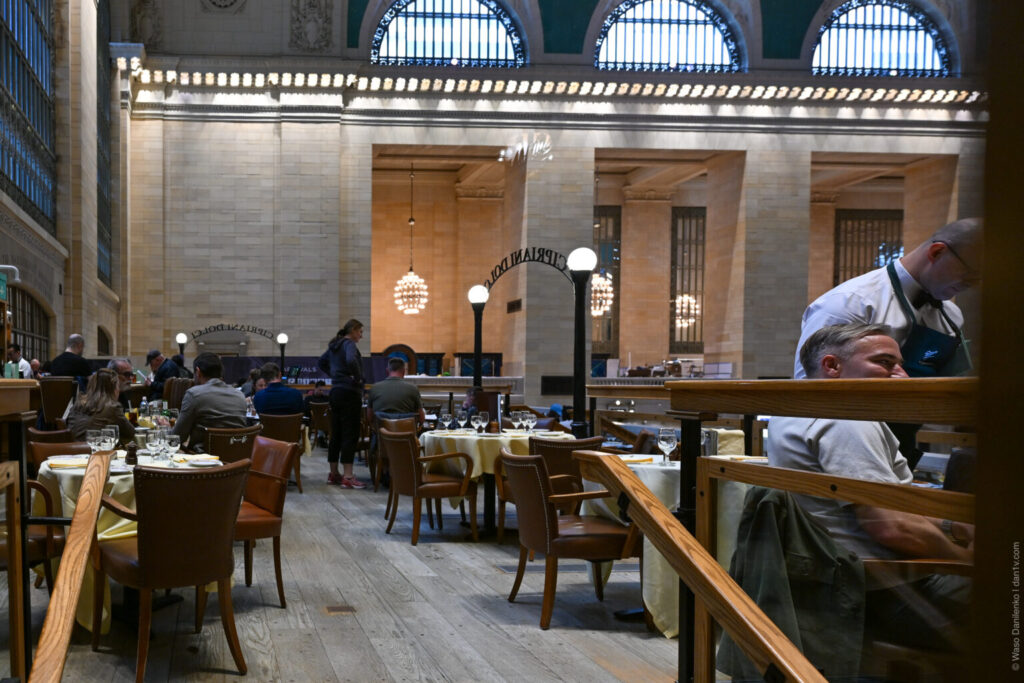
The Campbell Bar
New York is a city that knows how to hide its treasures. One of them is hidden right in Grand Central Terminal: the elegant and mysterious bar The Campbell.
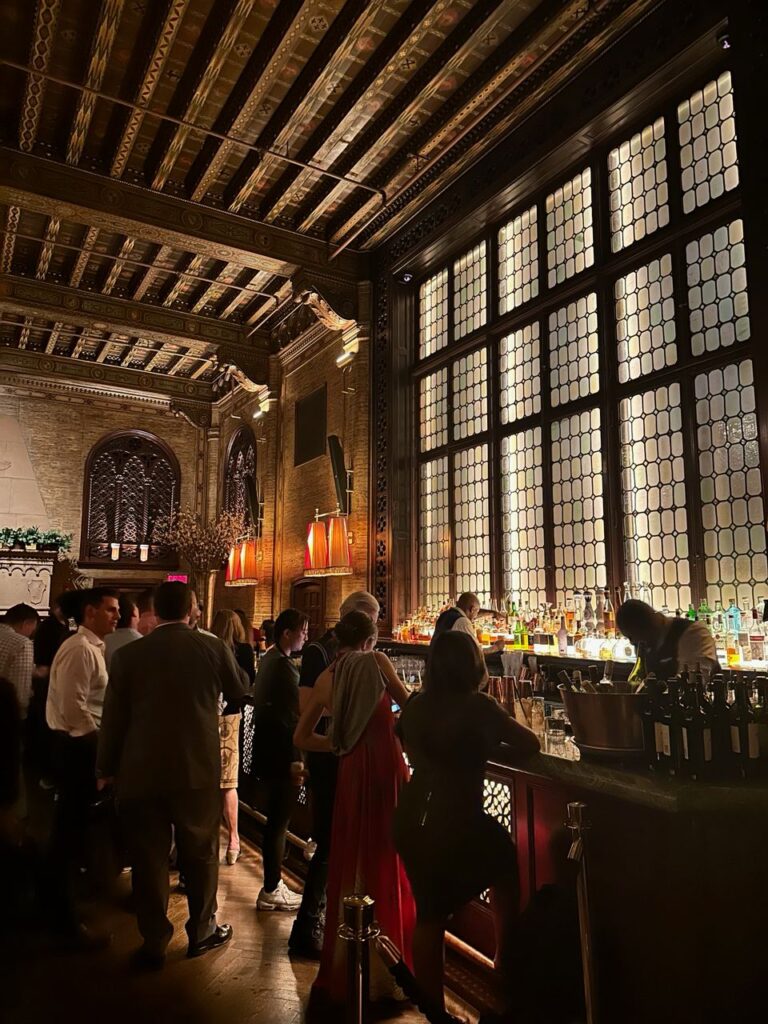
In the 1920s, this place was the personal office and salon of millionaire John William Campbell. He adored luxury and designed the interior in the style of an Italian Renaissance palazzo, complete with a fireplace, painted ceilings, and antique details.
As is often the case, the place has its own history: after serving as the office of a millionaire during America’s Golden Age, the space became a signalman’s office, and then a transit police office, where officers stored weapons and other equipment. A small jail, located on the site of the current bar, also stood here.
Today, The Campbell is a unique cocktail bar that preserves the atmosphere of the Roaring Twenties. Its signature drink, the legendary Prohibition Punch, will transport you back to the Prohibition era.
A cocktail at this legendary spot will cost you about $30.
📍 The bar is hidden behind an unassuming door on the west side of Grand Central. You can enter from the One Vanderbilt building or take the elevator down from the north side of Grand Central Terminal.
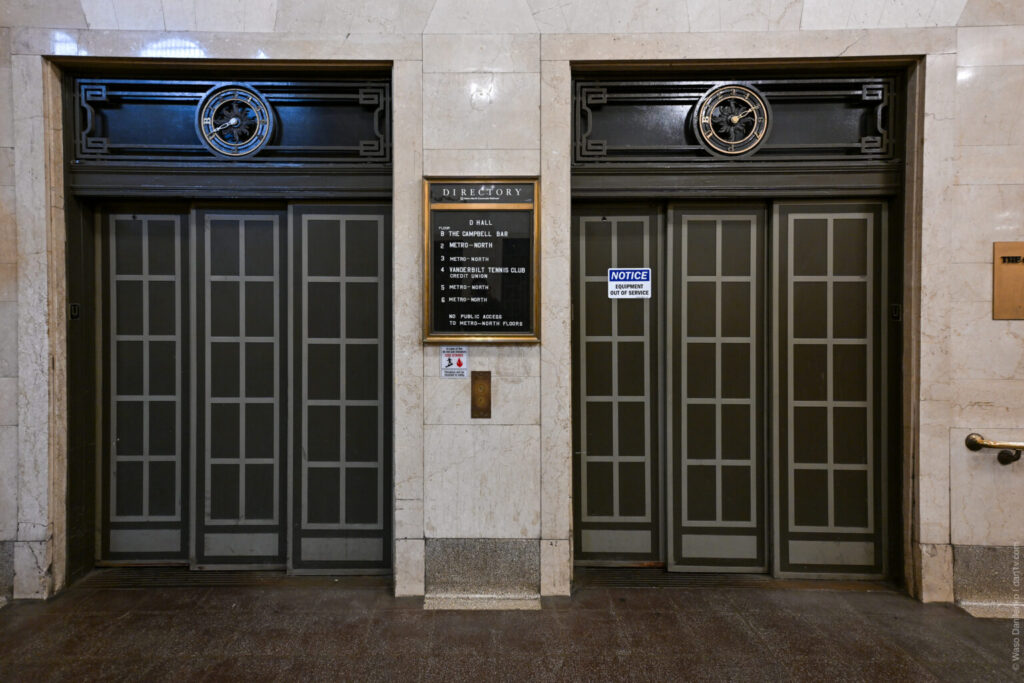
Food court, coffee shops and mini markets
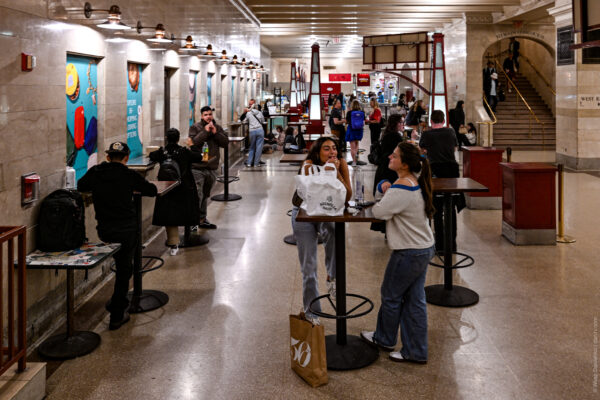
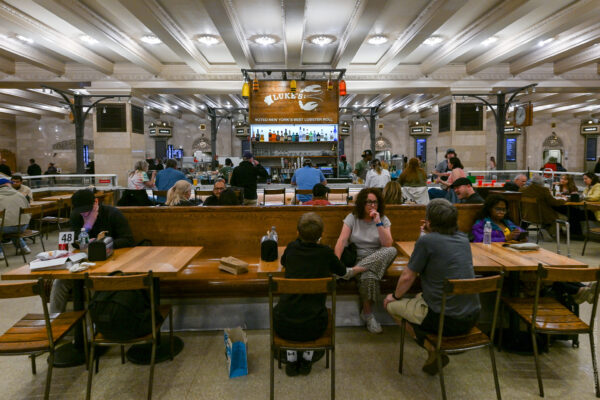
Grand Central Terminal is a culinary world in miniature: from legendary oysters and French cuisine to trendy coffee shops, bakeries and wine bars.
- Shake Shack — a cult chain of burgers, milkshakes, and fries. Vegetarian burgers are also on the menu.
- Luke’s Lobster — lobster, crab and shrimp sandwiches, as well as chowder.
- Tartinery — French open sandwiches and wines.
- Prova Pizzabar — pizza, there is a separate bar and sports broadcasts.
- Dirty Taco — Los Angeles style tacos.
- Veselka — Ukrainian cuisine: borscht, varenyky, cabbage rolls, pies, as well as classic American dishes.
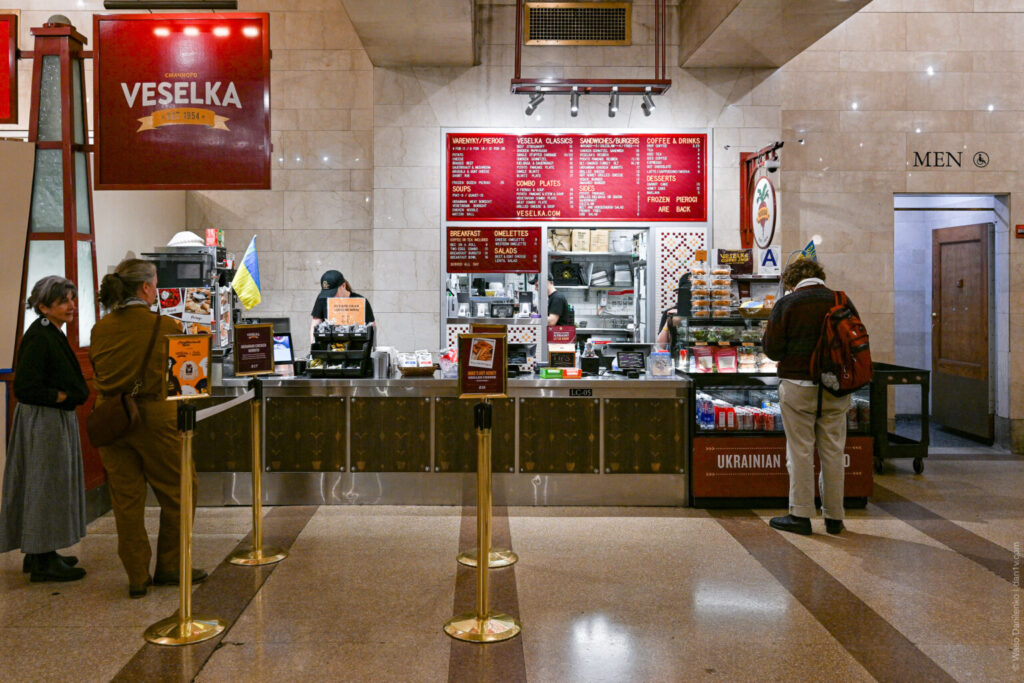
Coffee shops, pastries and desserts:
- Magnolia Bakery — famous cupcakes and banana pudding.
- Doughnut Plant — signature donuts, including Tres Leches and Brooklyn Blackout.
- Bourke Street Bakery — Australian baked goods, pies, croissants.
- Bien Cuit — French pastries and bread.
- Café Grumpy — specialty coffee and fresh baked goods.
Gastronomic market
Grand Central Market is a legendary food market located right inside Grand Central Terminal. Open daily from 5:15 AM to 2:00 AM, it’s one of Manhattan’s most famous and authentic food markets. The market features over a dozen stalls and boutiques specializing in fresh produce, delicacies, prepared foods, baked goods, and gifts.
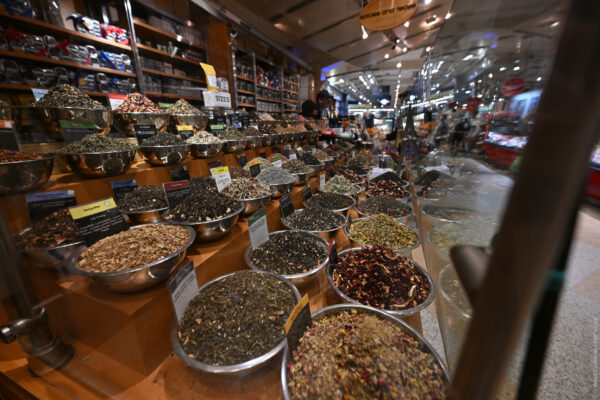
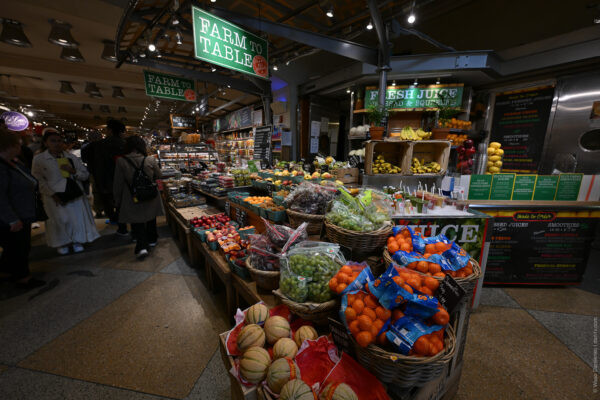
Transportation Museum inside Grand Central Terminal
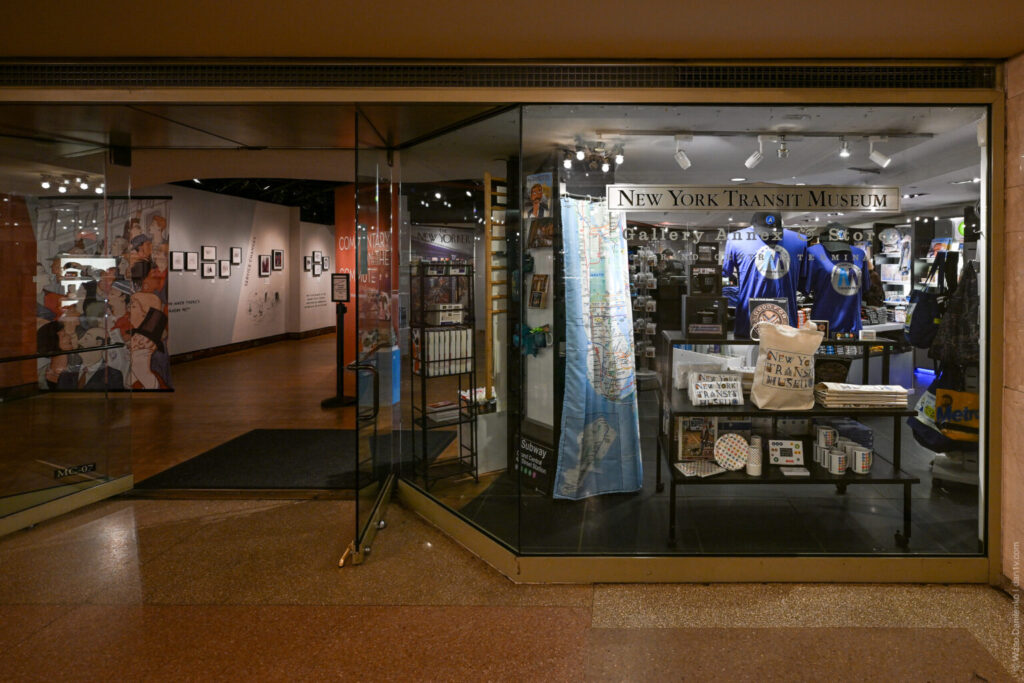
Few people know this, but hidden right inside Grand Central Terminal is a mini-museum dedicated to New York City transportation — the New York Transit Museum.
The museum hosts regular exhibitions dedicated to the history of New York City transportation, from vintage trains to unique photographs and artifacts. Although, in size, it’s reminiscent of a mini-gallery: the entire exhibition fits onto a few walls, typically featuring illustrations or photographs.
Most of the museum space is occupied by a souvenir shop selling books, merchandise, and gifts related to railroads, transportation, and the New York City subway.
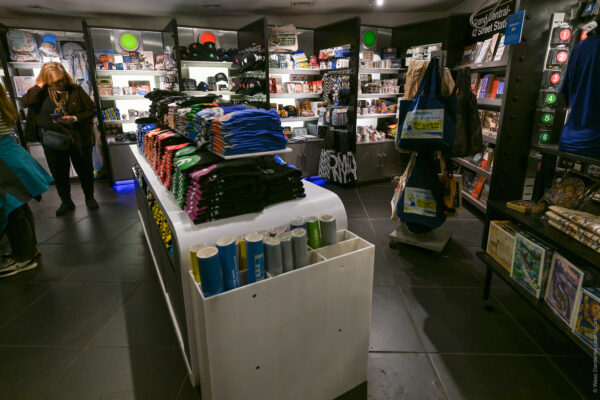
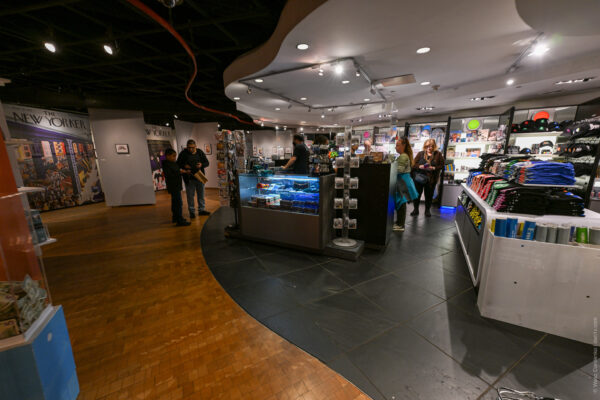
Typically, around Christmastime, the museum unveils one of its most beloved exhibits: the famous Holiday Train Show—a scale model railroad with miniature trains running through tiny New York City.
The gallery is located near Vanderbilt Hall (next to the main concourse of the station). Admission is always free.
Apple Store
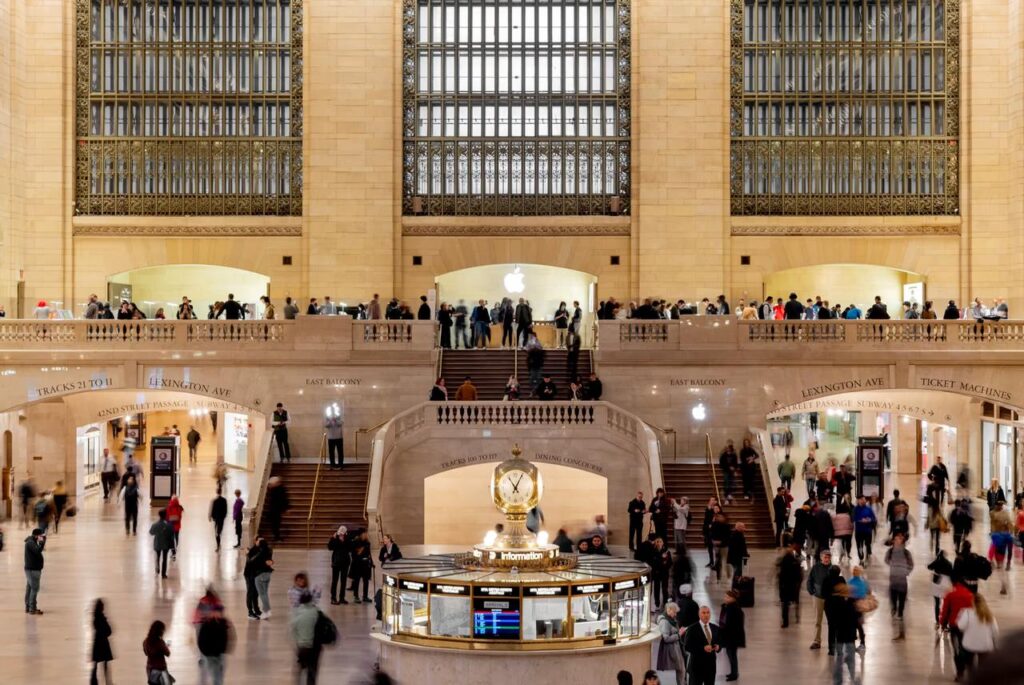
One of the most beautiful Apple stores in the world is located right inside New York City’s iconic Grand Central Terminal. The store is spectacularly located on the balcony of the main concourse’s east wing, perfectly blending into the station’s historic architecture.
- Spectacular views of the terminal’s magnificent interior with its iconic star-studded ceiling.
- The store’s open space seamlessly complements the classic aesthetic of the station.
- This is one of the few Apple retail locations that uses almost no traditional glass walls or partitions.
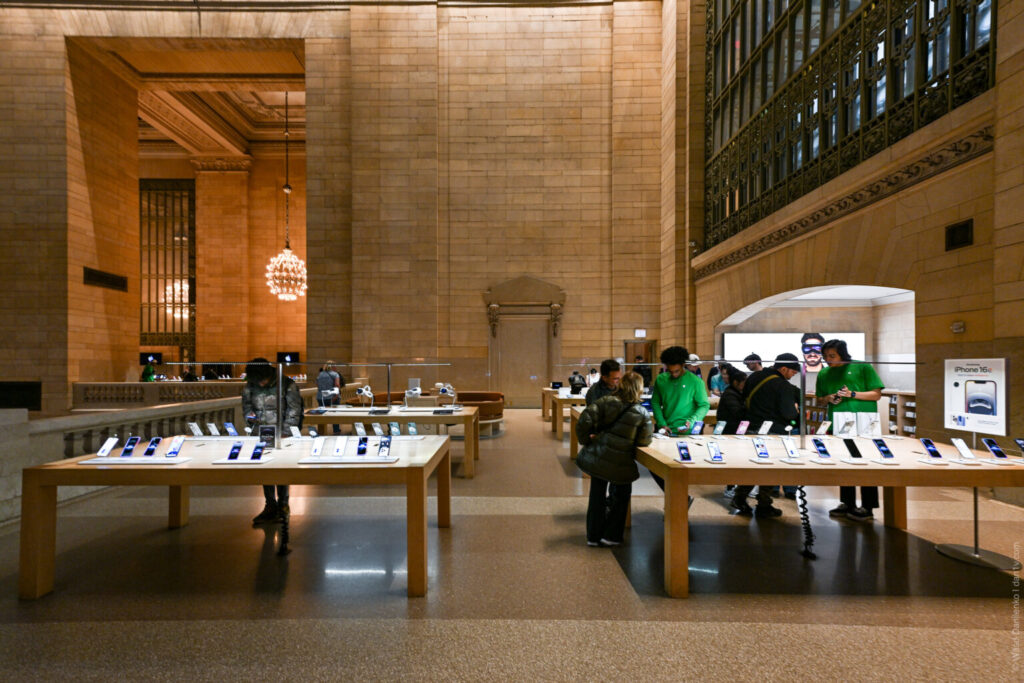
Even if you’re not planning on buying a new iPhone or MacBook, stop by to admire the unusual blend of modern technology and New York City’s architectural heritage.
Tours of New York’s Grand Central Terminal
Grand Central Terminal doesn’t offer tours itself, but it officially recommends the tour provider Walks. The tour lasts approximately one and a half hours in English, with a maximum of 20 people per group, and costs $39.
You can purchase it on the website: grandcentralterminal.com/guided-tour
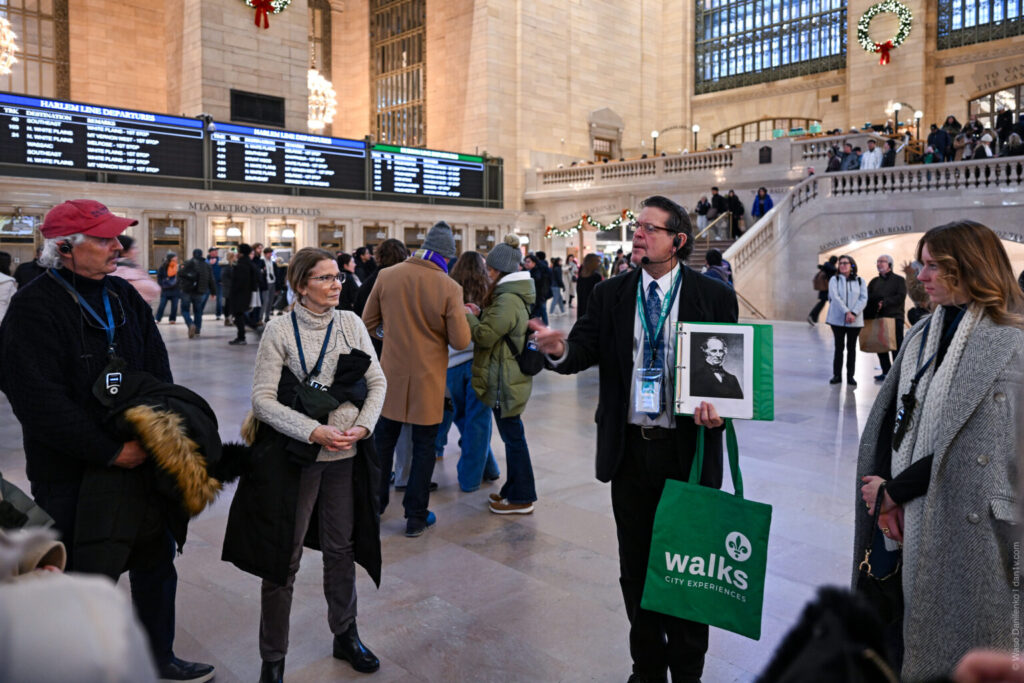
NY Adventure Club ($35 + tax) and Untapped New York ($39) also offer their own tours of Grand Central Terminal.

